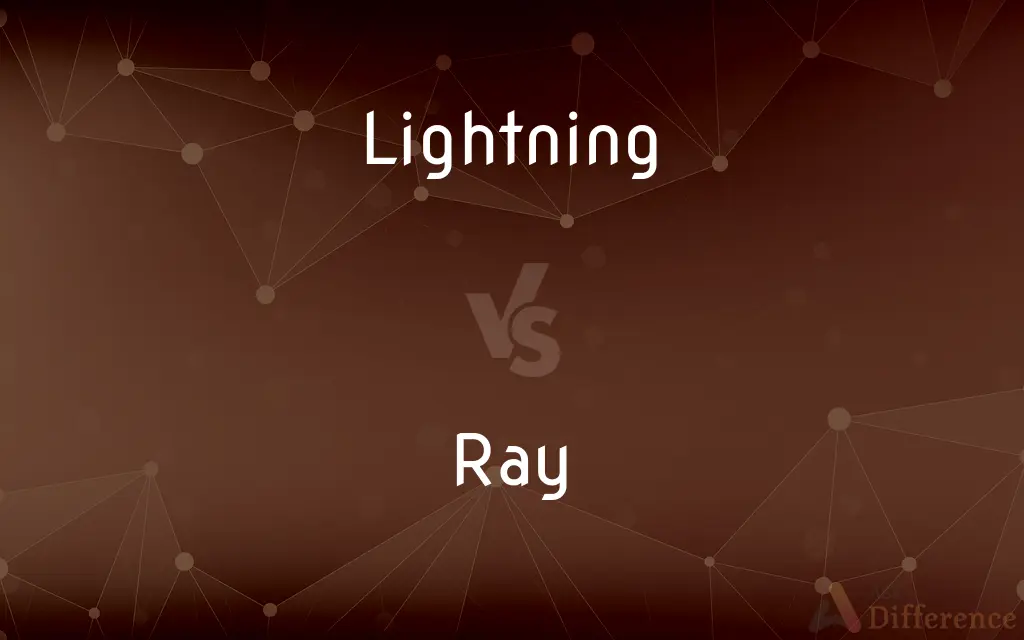Lightning vs. Ray — What's the Difference?
Edited by Tayyaba Rehman — By Maham Liaqat — Updated on April 5, 2024
Lightning is a natural, high-voltage electrical discharge between a cloud and the ground, or within a cloud, while a ray refers to a line or beam of light or other radiation, emanating from a source and traveling in a straight path.

Difference Between Lightning and Ray
Table of Contents
ADVERTISEMENT
Key Differences
Lightning is a meteorological phenomenon involving the sudden discharge of electricity accumulated in storm clouds. This discharge can occur between clouds, within a single cloud, or between a cloud and the ground, producing a bright flash and a thunderous sound due to rapid heating and expansion of the air. Lightning is a powerful and unpredictable force, often associated with thunderstorms, and can cause significant damage to structures and natural landscapes, as well as being a hazard to life.
A ray, in the context of physics and optics, is an idealized model representing the path of light or other forms of electromagnetic radiation. Rays are used to describe how light travels in a straight line from a source until it encounters an object where it can be absorbed, reflected, or refracted. This concept is fundamental in the study of geometric optics, where rays are used to analyze how lenses, mirrors, and other optical systems form images. Unlike lightning, rays are not physical entities but theoretical constructs that help in understanding the behavior of light and its interaction with materials.
While lightning is a transient and dynamic event resulting from specific atmospheric conditions, a ray is a continuous and predictable path that light or radiation follows under normal circumstances. The study of lightning falls within the fields of meteorology and atmospheric science, focusing on understanding and predicting weather patterns and phenomena. In contrast, the study of rays is crucial in physics and engineering, particularly in designing optical devices and understanding vision and light behavior.
Lightning's impact is primarily physical, with the potential for both destructive power and natural fertilization of the soil through nitrogen fixation. Rays, however, have a broader range of applications, from the simple task of illuminating spaces to complex uses in technology and medicine, such as in lasers, X-rays, and telecommunications. The analysis of rays extends into various scientific and technological fields, emphasizing the manipulation and control of light for beneficial purposes.
Both lightning and rays highlight the diverse nature of electromagnetic phenomena, from the raw power of natural electrical discharges to the precision of light paths that underpin modern optical technologies. They illustrate the spectrum of electromagnetic interactions, from the chaotic forces of weather to the structured principles of geometric optics.
ADVERTISEMENT
Comparison Chart
Nature
Natural electrical discharge
Idealized model of light or radiation path
Occurrence
During thunderstorms, unpredictable
Continuous, predictable
Study Field
Meteorology, atmospheric science
Physics, optics
Behavior
Transient, dynamic
Straight-line path until interaction
Impact
Can cause damage, thunder sound
Used in optics, imaging, technology
Representation
Physical phenomenon
Theoretical construct
Applications
Weather forecasting, atmospheric research
Optical devices, medical imaging, communication
Compare with Definitions
Lightning
Can occur between clouds or ground.
We observed intra-cloud lightning before it started raining.
Ray
Path of light or radiation.
A ray of sunlight broke through the clouds.
Lightning
Causes bright flashes and thunder.
Lightning illuminated the sky, followed by loud thunder.
Ray
Travels in a straight line.
Shadows are formed when an object blocks the path of light rays.
Lightning
Studied for weather prediction.
Meteorologists study lightning patterns to forecast severe storms.
Ray
Used in optical models.
The physics class studied how rays pass through different lenses.
Lightning
Electrical discharge during storms.
The tree was struck by lightning during the thunderstorm.
Ray
Applications in technology, medicine.
X-ray machines use rays to image bones and organs.
Lightning
Unpredictable, powerful.
Lightning strikes can cause fires and damage to infrastructure.
Ray
Fundamental in optics.
Engineers use the concept of rays to design cameras and telescopes.
Lightning
Lightning is a naturally occurring electrostatic discharge during which two electrically charged regions, both in the atmosphere or with one on the ground, temporarily equalize themselves, causing the instantaneous release of as much as one gigajoule of energy. This discharge may produce a wide range of electromagnetic radiation, from very hot plasma created by the rapid movement of electrons, to brilliant flashes of visible light in the form of black-body radiation.
Ray
A narrow stream of radiant energy, especially visible light, traveling in a straight or nearly straight line.
Lightning
An abrupt, discontinuous natural electric discharge in the atmosphere.
Ray
A narrow stream of particles such as protons traveling in a straight or nearly straight line.
Lightning
The visible flash of light accompanying such a discharge.
Ray
A rapidly moving particle traveling in a straight or nearly straight line.
Lightning
(Informal) A sudden, usually improbable stroke of fortune.
Ray
Rays Sunshine
Let's go to the beach and catch some rays.
Lightning
To discharge a flash of lightning.
Ray
A small amount; a trace
Not a ray of hope left.
Lightning
Moving or occurring with remarkable speed or suddenness.
Ray
(Mathematics) A straight line extending from a point. Also called half-line.
Lightning
A flash of light produced by short-duration, high-voltage discharge of electricity within a cloud, between clouds, or between a cloud and the earth.
Although we did not see the lightning, we did hear the thunder.
Ray
Any of the bright streaks that are seen radiating from some craters on the moon.
Lightning
A discharge of this kind.
The lightning was hot enough to melt the sand.
That tree was hit by lightning.
Ray
A ray flower or the strap-shaped portion of the corolla of a ray flower.
Lightning
(figuratively) Anything that moves very fast.
Ray
A branch of an umbel.
Lightning
Rfv-sense|en}} {{obsolete form of lightening
Ray
One of the bony spines supporting the membrane of a fish's fin.
Lightning
Extremely fast or sudden; moving (as if) at the speed of lightning.
Ray
One of the arms of a starfish or other radiate animal.
Lightning
To produce lightning.
Ray
Any of various cartilaginous fishes of the superorder Batoidea, having ventral gill slits, enlarged pelvic fins that are fused to the sides of the head, and a flattened body, and including the stingrays, skates, and guitarfishes.
Lightning
A discharge of atmospheric electricity, accompanied by a vivid flash of light, commonly from one cloud to another, sometimes from a cloud to the earth. The sound produced by the electricity in passing rapidly through the atmosphere constitutes thunder.
Ray
Any of various members of this superorder having a whiplike tail usually with a stinging spine, such as a stingray, considered in contrast to a guitarfish, sawfish, or skate.
Lightning
The act of making bright, or the state of being made bright; enlightenment; brightening, as of the mental powers.
Ray
To send out as rays; emit.
Lightning
Lightening.
Ray
To supply with rays or radiating lines.
Lightning
Abrupt electric discharge from cloud to cloud or from cloud to earth accompanied by the emission of light
Ray
To cast rays on; irradiate.
Lightning
The flash of light that accompanies an electric discharge in the atmosphere (or something resembling such a flash); can scintillate for a second or more
Ray
A beam of light or radiation.
I saw a ray of light through the clouds.
Ray
(zoology) A rib-like reinforcement of bone or cartilage in a fish's fin.
Ray
(zoology) One of the spheromeres of a radiate, especially one of the arms of a starfish or an ophiuran.
Ray
(botany) A radiating part of a flower or plant; the marginal florets of a compound flower, such as an aster or a sunflower; one of the pedicels of an umbel or other circular flower cluster; radius.
Ray
(obsolete) Sight; perception; vision; from an old theory of vision, that sight was something which proceeded from the eye to the object seen.
Ray
(mathematics) A line extending indefinitely in one direction from a point.
Ray
(colloquial) A tiny amount.
Unfortunately he didn't have a ray of hope.
Ray
A marine fish with a flat body, large wing-like fins, and a whip-like tail.
Ray
(obsolete) Array; order; arrangement; dress.
Ray
The letter ⟨/⟩, one of two which represent the r sound in Pitman shorthand.
Ray
(music) re
Ray
(transitive) To emit something as if in rays.
Ray
(intransitive) To radiate as if in rays.
Ray
(transitive) To expose to radiation.
Ray
(obsolete) To arrange.
Ray
To dress, array (someone).
Ray
(obsolete) To stain or soil; to defile.
Ray
To array.
Ray
To mark, stain, or soil; to streak; to defile.
Ray
To mark with long lines; to streak.
Ray
To send forth or shoot out; to cause to shine out; as, to ray smiles.
Ray
To shine, as with rays.
Ray
Array; order; arrangement; dress.
And spoiling all her gears and goodly ray.
Ray
One of a number of lines or parts diverging from a common point or center, like the radii of a circle; as, a star of six rays.
Ray
A radiating part of a flower or plant; the marginal florets of a compound flower, as an aster or a sunflower; one of the pedicels of an umbel or other circular flower cluster; radius. See Radius.
Ray
One of the radiating spines, or cartilages, supporting the fins of fishes.
Ray
A line of light or heat proceeding from a radiant or reflecting point; a single element of light or heat propagated continuously; as, a solar ray; a polarized ray.
Ray
Sight; perception; vision; - from an old theory of vision, that sight was something which proceeded from the eye to the object seen.
All eyes direct their raysOn him, and crowds turn coxcombs as they gaze.
Ray
One of a system of diverging lines passing through a point, and regarded as extending indefinitely in both directions. See Half-ray.
Ray
Any one of numerous elasmobranch fishes of the order Raiæ, including the skates, torpedoes, sawfishes, etc.
Ray
A column of light (as from a beacon)
Ray
A branch of an umbel or an umbelliform inflorescence
Ray
(mathematics) a straight line extending from a point
Ray
A group of nearly parallel lines of electromagnetic radiation
Ray
The syllable naming the second (supertonic) note of any major scale in solmization
Ray
Any of the stiff bony rods in the fin of a fish
Ray
Cartilaginous fishes having horizontally flattened bodies and enlarged winglike pectoral fins with gills on the underside; most swim by moving the pectoral fins
Ray
Emit as rays;
That tower rays a laser beam for miles across the sky
Ray
Extend or spread outward from a center or focus or inward towards a center;
Spokes radiate from the hub of the wheel
This plants radiates spines in all directions
Ray
Expose to radiation;
Irradiate food
Common Curiosities
How are lightning and rays studied differently?
Lightning is studied within meteorology and atmospheric sciences to understand weather phenomena, while rays are examined in physics and optics to analyze light behavior and design optical systems.
What defines a ray?
A ray is an idealized line that represents the path of light or electromagnetic radiation traveling from a source in a straight direction until it interacts with an object.
What is lightning?
Lightning is a natural electrical discharge caused by imbalances between storm clouds and the Earth's surface, or within the clouds themselves, resulting in a bright flash and thunder.
Can lightning be considered a form of ray?
No, lightning is a physical phenomenon involving electrical discharge, whereas a ray is a theoretical construct used to describe the path of light or radiation.
What safety measures are important for lightning?
Safety measures include seeking shelter indoors during thunderstorms, avoiding tall structures and bodies of water, and using lightning rods to protect buildings.
What are the practical applications of rays?
Rays have wide-ranging applications, including in optical devices like lenses and mirrors, medical imaging techniques such as X-rays, and in telecommunications and laser technology.
How do rays contribute to our understanding of the universe?
Rays help scientists understand the properties of light and electromagnetic radiation, contributing to discoveries in areas ranging from the structure of atoms to the behavior of distant stars.
How do optical engineers use rays in their work?
Optical engineers use the concept of rays to design and analyze systems that manipulate light, such as cameras, telescopes, and fiber optic cables.
What are the differences in impact between lightning and rays?
Lightning can cause physical damage and is a hazard during storms, while rays are harnessed for various beneficial purposes, from lighting and vision to advanced technological applications.
What role does lightning play in the Earth's atmosphere?
Lightning plays a significant role in the Earth's nitrogen cycle by helping to fix nitrogen in the soil, and it influences atmospheric chemistry by producing ozone and other gases.
Share Your Discovery

Previous Comparison
Ambiguity vs. Pun
Next Comparison
Ragtop vs. ConvertibleAuthor Spotlight
Written by
Maham LiaqatEdited by
Tayyaba RehmanTayyaba Rehman is a distinguished writer, currently serving as a primary contributor to askdifference.com. As a researcher in semantics and etymology, Tayyaba's passion for the complexity of languages and their distinctions has found a perfect home on the platform. Tayyaba delves into the intricacies of language, distinguishing between commonly confused words and phrases, thereby providing clarity for readers worldwide.














































